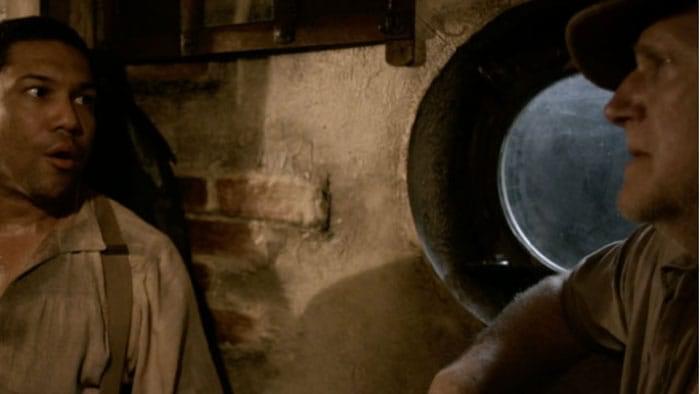
Already in full swing, the 21st edition of the Environmental Film Festival sports 190 widely diverse films being screened around Washington DC. Of the 190 films from 50 countries, 110 will be having local, U.S., or world premieres, with many of the filmmakers in attendance to provide Q+A support. One of the films with its planetary unveiling is the Austria/Germany (some dialogue in German, with English subtitles, and fully English narrated) feature “The Age of Aluminium,” with director Bert Ehgartner being part of a post-screening panel discussion on March 20th, 2013.
Based on his own book “Dirty Little Secret—The Aluminium Files,” Ehgartner examines the omnipresent silvery white metal that touches us every day in many ways. It is, after oxygen and silicon, the third most abundant element. No other metals are more plentiful. It’s nearly a tenth of the world’s solid surface weight. It’s also a neurotoxin. Bet you din’t know that. Touch any of the following and it’s aluminium: soda/beer cans, bicycle frames, building materials, packaging, lots of car parts, shower stalls, toothpaste, cosmetics, even naked women. Oops, how did that last one get in there? It’s not for comic effect, believe me. It’s part of the small tragedy that bookmarks the film.
Just as you examine the barely pronounceable ingredients on any number of items on the grocery shelf for fat or diet-related ingredients, a young Frankfurt midwife, Eva Glave, learns that some chemicals can cause medical issues and has probably contributed to hers—she has already had a partial mastectomy and has cysts in her other breast. Despite her avid use of deodorant—she produces a fierce profusion of sweat—apparently the substance aluminium chlorohydrate is a no-no (and two-thirds of all deodorants contain such compounds). An oncologist provides alarming information about armpits (honest!) and exposure to various cosmetic industry additives. Buttressing the aluminum industry is one of their own toxicologists who purports that there is no evidence that the small fraction of metal that gets absorbed by the body does it no harm “Most of that does not penetrate the skin.” A spokesperson for the European Department of Medical Assessment that says no action need be taken. Ehgartner obviously is no supporter of the latter hypothesis.
Norsk Hydro, Europe biggest company associated with the metal, offers up a research and development manager, Werner Jager, as the first of several talking heads in this production, making you wonder if the film is merely an industry-sponsored promotional piece. Especially when some of the interspersed “family” sequences, with accompanying canned music, pushes too much “fun” into some of the staged sequences, where a mom-dad-son-daughter unit are brushing their teeth (together!), affixing a tire to the car, or drinking from generic cans.
As for Jager, the cameras follow him to Porto Trombetas in Brazil, where his company runs a huge bauxite mine. Located close to the earth’s surface, the narration casually mentions that “large areas of rainforest” have to be sacrificed. Nothing but tractors, big trucks, and other mining equipment is shown raping the red-tinged earth around the clock, pushing up company profits and depleting resources. The camera pans across the destruction as the narrator offers nonchalant observations. To assuage any distaste, as a post script, we’re told that Norsk Hydro is reforesting (it’s obligatory), but it takes 20-40 years to rebuild. “In only three decades time, it will all be green again.”
Feeling sad yet? Read on.
There are other experts in the parade. A harrowing visit from an environmental toxicologist warns us about acid rain (which releases trace amounts of the metal, just enough to kill salmon). Kidney specialist Herwig Holzer talks of neurological, stroke-like disorders caused by medicines containing aluminium hydroxide. A sufferer of Alzheimer’s-like symptoms can’t draw a simple clock in one test, and his wife, wondering what to make of it all, opens a bathroom drawer to show it packed with medicines her husband has taken for decades of heartburn relief. Hidden in the drug’s warning papers: “long term use of high doses may lead to aluminium deposits in nerve and bone tissue.” Dementia is a possible side effect. Whatever neurological problems develop, they are currently irreversible. Ugh.
Other stories provide more anguish. A Brazilian fishing village polluted by dust from a nearby, long-thriving refinery—a structure that is so immense it has tripled the size of the the once sleepy Bacarena and caused other social, class, and poignantly obvious medical issues to arise. The local workers know of the poisons mixed with caustic soda. There’s millions and millions of red toxic sludge sitting atop its own mountain, a huge expanse filling the landscape. In Ajka, Hungary, runaway caustic mud a few years back created one of Europe’s worst ever environmental disasters. Even the 9-11 destruction of the Twin Towers is discussed, showing molten aluminium falling before the buildings’ collapse.
The evidence is alarming, yet the film’s approach. at least initially, is an even-keeled, determined story line, although the urgency does surge over the last two-thirds of the film. There are no spicy editing or graphics. No Werner Herzog extorting on the soundtrack (Ehgartner apparently does his own narration). I admire the film’s honest camera technique, like an observer chronicling the ills of mankind. I suspect some of his subjects might be upset that their comments appeared in this ultimately damning documentary. I can hear Erin Brockovich crying out for the damaged souls.
There’s a lot of bad s**t in the world. You wouldn’t think aluminium would be one of them. “The Age of Aluminium” puts us on notice.
